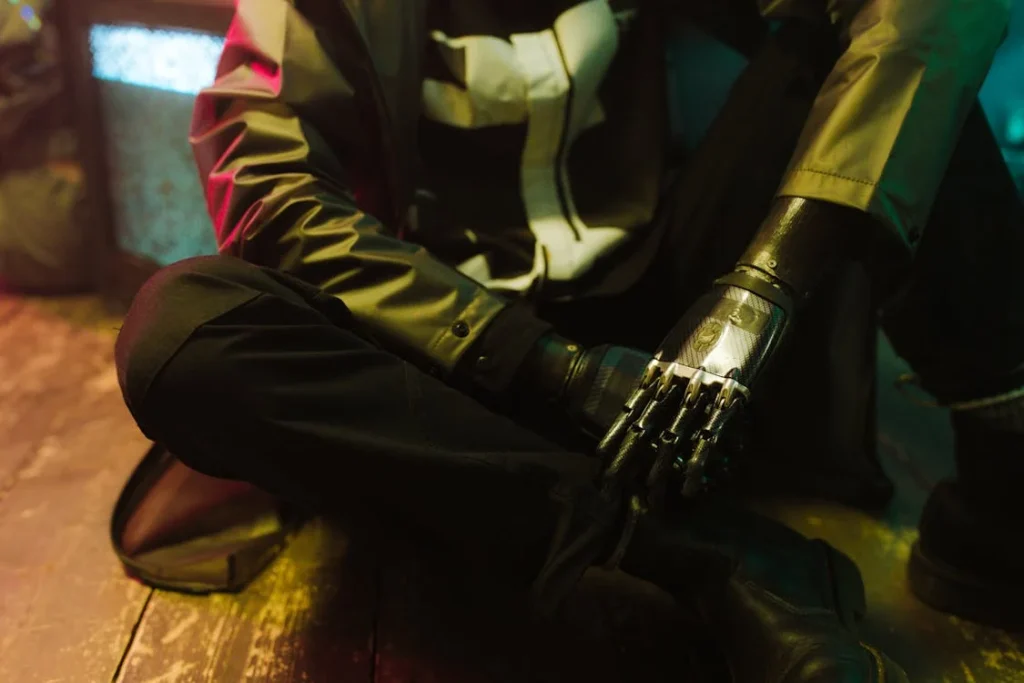Losing an upper limb can feel like losing a part of one’s independence. Simple everyday tasks—buttoning a shirt, writing a note, holding a loved one’s hand—become challenging. But with the advancements in prosthetic technology, individuals who once struggled are now regaining their confidence, mobility, and sense of self.
Prosthetic hands and arms are no longer just mechanical replacements; they are tools of empowerment. They help people return to work, rediscover hobbies, and even take on new challenges they never thought possible. Behind every prosthetic limb is a story of resilience, determination, and hope.
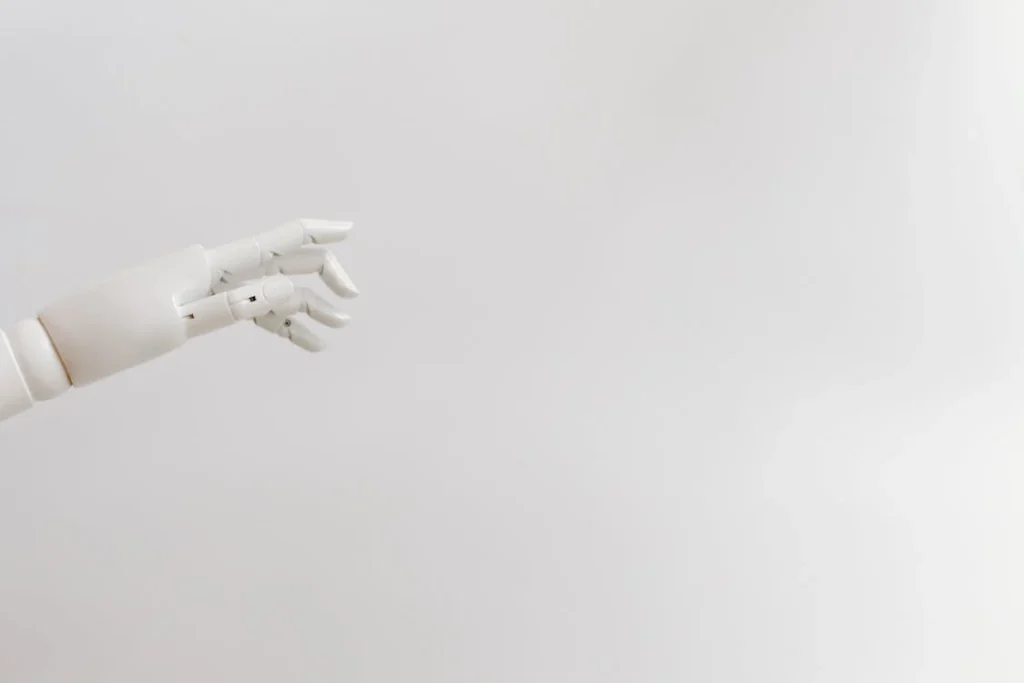
Regaining Independence After Limb Loss
Losing an arm or a hand can make even the simplest tasks feel overwhelming.
Many individuals find themselves struggling to do things they once took for granted—tying their shoelaces, cooking a meal, or even holding a pen.
But with the help of advanced prosthetic technology, these challenges can be overcome.
Prosthetic limbs do not just restore function; they give people back their independence.
Returning to Everyday Activities
For many prosthetic users, the first goal is to regain control over daily tasks.
The journey often begins with learning how to use the prosthetic for basic functions such as gripping objects, opening doors, and performing self-care routines.
Initially, there is an adjustment period where movements may feel unnatural or slow.
But with practice, patience, and guidance from rehabilitation experts, users gradually gain confidence.
One inspiring story is that of Amit, a school teacher who lost his right hand in an accident.
After months of struggling with daily tasks, he was fitted with a bionic hand. At first, he was unsure if he would be able to hold chalk or turn the pages of a book smoothly.
But through guided training and practice, he mastered these skills. Today, he not only teaches as effectively as before but also demonstrates to his students that resilience can overcome any obstacle.
The Role of Personalized Prosthetics
Each individual’s needs are different, and a well-fitted prosthetic can make all the difference in comfort and usability.
Modern prosthetics are customized to match the user’s limb structure, lifestyle, and daily requirements.
Advanced materials make them lighter, more comfortable, and easier to wear for long periods.
Take the story of Rina, a young mother who lost her left hand in a road accident.
Her biggest worry was whether she would still be able to take care of her child—feeding, dressing, and carrying her baby.
With a customized myoelectric prosthetic hand, she gradually learned how to grip a spoon, hold a baby bottle, and even fasten buttons.
The prosthetic allowed her to embrace motherhood with confidence, proving that she could still do everything she needed for her child.
Overcoming Mental and Emotional Barriers
The journey to using a prosthetic limb is not just physical—it is deeply emotional.
Many individuals face feelings of frustration, loss, and self-doubt.
Initially, it can be difficult to accept the change, but support from family, friends, and rehabilitation specialists plays a crucial role.
For Vikram, a former athlete, losing his arm in an industrial accident was devastating. He was unsure if he would ever return to an active lifestyle.
However, with the encouragement of his prosthetist and loved ones, he began training with a prosthetic arm designed for sports activities.
Over time, he relearned how to lift weights and engage in physical fitness. Today, he not only trains daily but also participates in adaptive sports, inspiring others to push past their limitations.
Regaining independence after limb loss is a journey filled with challenges, but it is also one of resilience and triumph.
Prosthetic technology has opened doors that once seemed closed, allowing individuals to reclaim their daily lives with confidence.
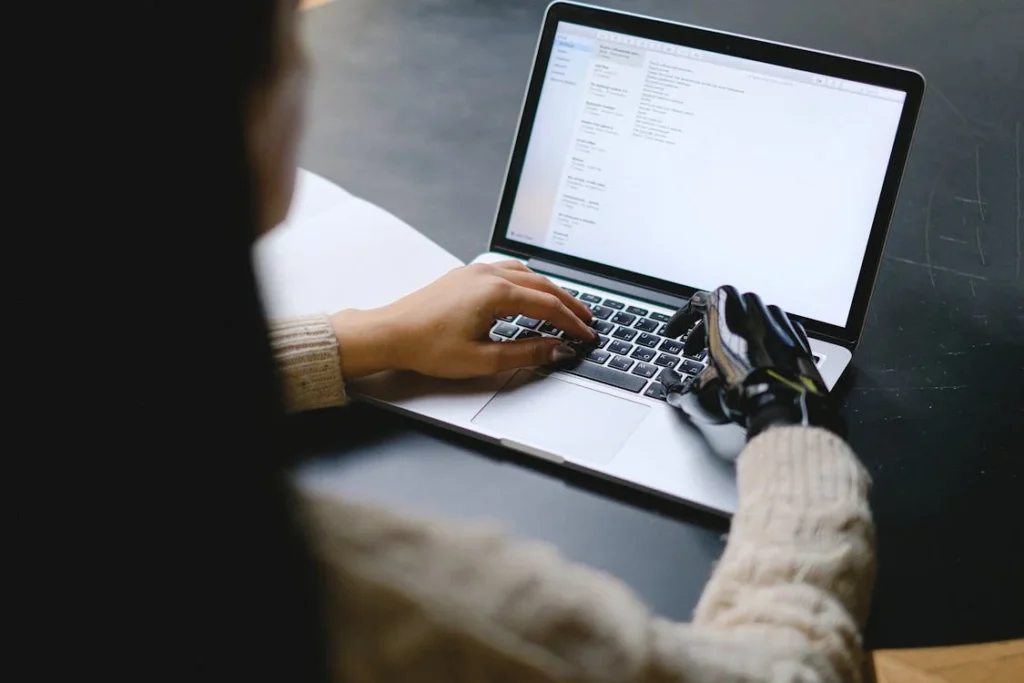
Redefining Careers and Professional Success
Losing an upper limb can feel like the end of a career for many individuals, especially those whose jobs rely on hand function.
However, prosthetic technology is proving that limb loss does not mean the loss of a career.
With the right support, training, and assistive devices, individuals are returning to work, excelling in their fields, and even exploring new opportunities they never considered before.
Adapting to Work with a Prosthetic
For professionals in fields that require precision and manual dexterity, adapting to a prosthetic can be challenging at first.
The key is choosing the right type of prosthetic based on job requirements.
Some users benefit from mechanical prosthetics designed for strength, while others require myoelectric hands that provide fine motor control.
Rahul, an engineer, lost his dominant hand in a workplace accident. Initially, he feared that his career in design and construction would come to an end.
However, after being fitted with a myoelectric prosthetic hand, he gradually relearned how to handle tools, sketch designs, and operate machinery.
The advanced grip control allowed him to hold pens, rulers, and even power tools with precision.
Today, he continues his work with confidence, proving that adaptability and innovation go hand in hand.
Entrepreneurs and Business Owners Breaking Barriers
Some individuals take limb loss as an opportunity to redefine their career paths.
Instead of returning to traditional jobs, they venture into entrepreneurship, using their experiences to create businesses that help others.
Maya, a former artist, lost her right hand due to an infection. Devastated by the thought of never painting again, she initially struggled with feelings of loss.
However, with the support of rehabilitation specialists, she learned how to use a prosthetic arm equipped with an adaptive grip.
Slowly, she regained the ability to hold a paintbrush and experiment with different techniques.
Over time, she started a business selling artwork that showcased the beauty of resilience.
Her journey inspired others, and she now conducts workshops for individuals with disabilities who want to explore creative fields.
Returning to Healthcare and Skilled Professions
Healthcare professionals who experience limb loss often face unique challenges.
Their jobs require a combination of precision, strength, and sensitivity—qualities that can be difficult to replicate with a prosthetic.
However, modern technology is making it possible for doctors, nurses, and technicians to return to their fields with confidence.
Dr. Sameer, a surgeon, faced an uncertain future when he lost his left hand in an accident.
Determined to continue his work, he underwent months of rehabilitation and was fitted with a specialized prosthetic designed for medical professionals.
Through training and practice, he adapted to using surgical tools with a combination of his natural hand and prosthetic.
His determination led him back to the operating room, where he now performs procedures with the same skill and expertise as before.
Overcoming Workplace Challenges
Returning to work with a prosthetic limb comes with adjustments. Employers and colleagues may not always understand the capabilities of a prosthetic user.
Some tasks may need to be modified, and certain tools may require adaptations.
However, with the right mindset and workplace support, these challenges can be overcome.
Many organizations are now implementing inclusive policies that provide accommodations for employees with prosthetics.
Ergonomic workstations, voice-activated software, and adaptive tools are becoming more common, making it easier for prosthetic users to perform tasks efficiently.
Professional success is not defined by physical ability but by determination, adaptability, and the willingness to embrace new ways of working.
With advanced prosthetics and a supportive work environment, individuals are not just returning to their careers—they are excelling in them.
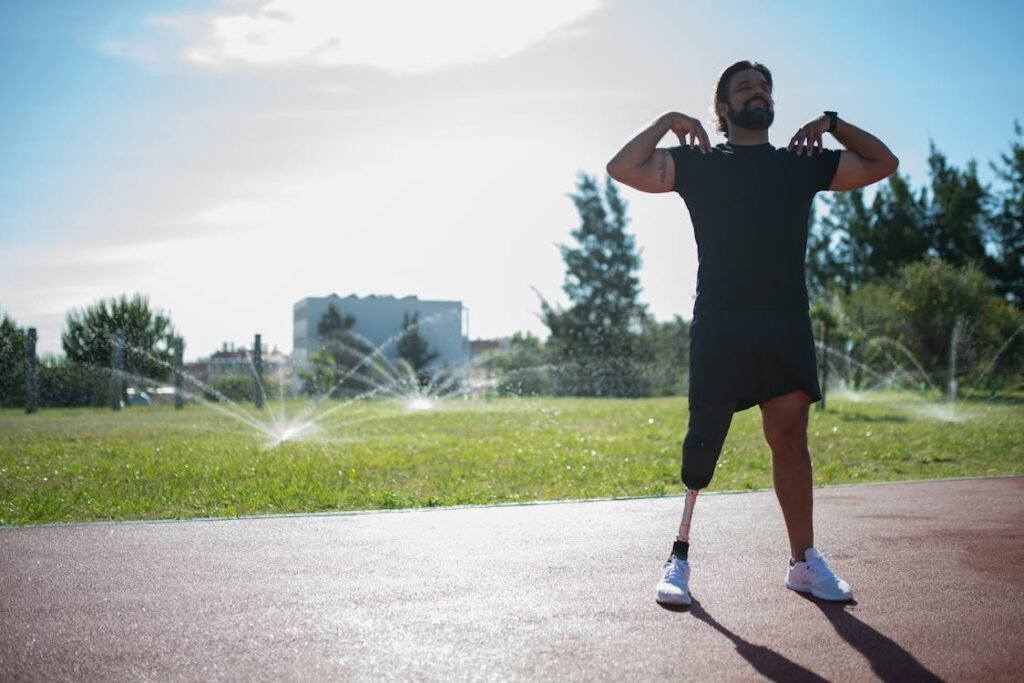
Embracing Sports and Physical Activities with Prosthetics
For many individuals who have experienced limb loss, returning to sports and physical activities can seem impossible at first.
The loss of an upper limb affects balance, coordination, and grip strength, all of which are essential for athletic performance.
However, advancements in prosthetic technology are breaking these barriers, allowing users to not only return to the sports they love but also compete at high levels.
Athletes Redefining Their Limits
Prosthetic technology is changing the way athletes approach training and competition.
With specially designed sports prosthetics, users can engage in activities that require gripping, swinging, throwing, or lifting weights.
These prosthetics are tailored to specific movements, providing the flexibility and durability needed for intense physical activity.
Arjun, a former cricket player, lost his right hand in an accident. Initially, he believed his days on the field were over.
However, after being fitted with a prosthetic hand designed for gripping a cricket bat, he slowly worked on his technique.
Through rehabilitation and determination, he regained control over his swings and improved his timing.
Today, he plays recreational matches and mentors young athletes who have experienced similar challenges, proving that sports remain accessible to everyone with the right support.
Training for Strength and Endurance
Physical fitness is crucial for prosthetic users. Strength training helps improve posture, reduces strain on the residual limb, and enhances endurance for everyday activities.
Many users incorporate strength and conditioning exercises into their routines to ensure they can fully utilize their prosthetics.
Deepa, a fitness enthusiast, struggled to continue her weightlifting routine after losing her left hand.
With the help of an adaptive prosthetic that allowed her to grip barbells and resistance bands, she gradually regained her strength.
She now trains regularly and shares her journey through social media, encouraging others to stay active despite physical challenges.
Competing in Adaptive Sports
Adaptive sports have provided a platform for individuals with limb loss to compete at professional levels.
Events such as the Paralympics, marathons, and cycling races include athletes who use prosthetics to enhance their performance.
Ravi, a former boxer, thought his career had ended after losing his arm. But with a specialized prosthetic designed for high-impact movements, he trained to develop new techniques and adapted his fighting style.
Today, he competes in adaptive boxing matches and teaches self-defense courses, demonstrating that resilience and adaptability can keep the spirit of competition alive.
The Mental and Emotional Benefits of Sports
Engaging in physical activities goes beyond physical strength—it boosts mental and emotional well-being.
Many prosthetic users find that sports help them regain confidence, reduce stress, and create a sense of normalcy after limb loss.
The sense of achievement that comes with setting and reaching fitness goals contributes to a more positive outlook on life.
Returning to sports and physical activities after limb loss is not just about regaining movement—it is about proving that limitations exist only in the mind.
With the right prosthetic technology, determination, and support, individuals can continue to pursue their passions and redefine their physical potential.
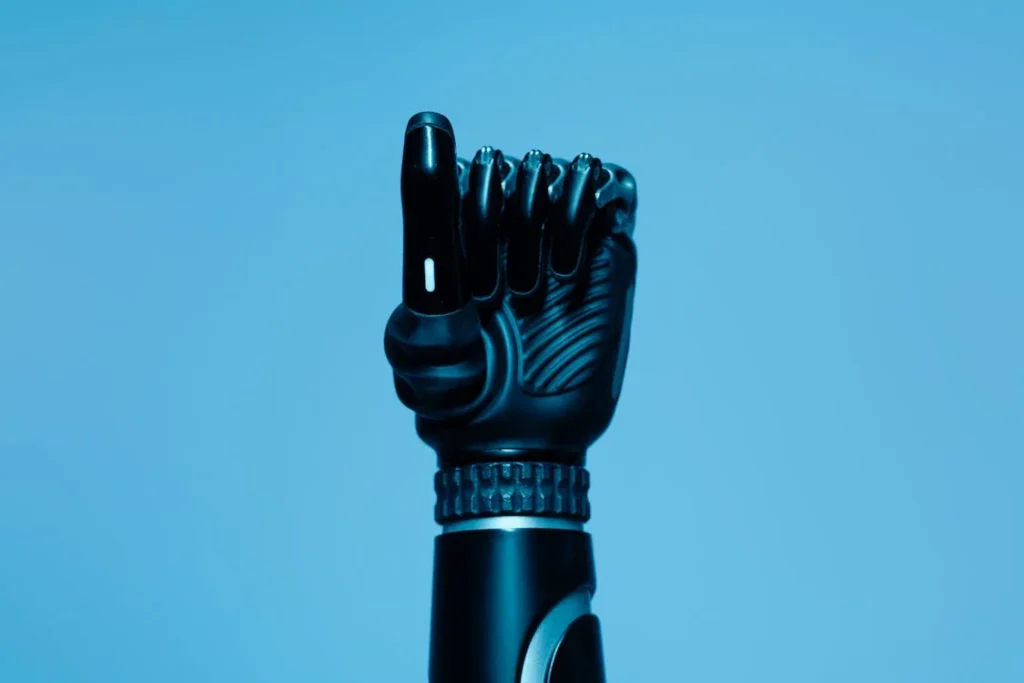
The Social and Emotional Impact of Upper Limb Prosthetics
Beyond restoring function, prosthetics play a significant role in helping individuals rebuild their confidence and reconnect with society.
Losing a limb can lead to feelings of isolation, self-consciousness, and anxiety about how others will perceive them.
However, with the right prosthetic and a supportive environment, many users find renewed self-esteem and a sense of belonging.
Rebuilding Confidence in Social Settings
One of the biggest challenges after limb loss is adjusting to public interactions.
Many individuals worry about how others will react to their prosthetic limb, leading to hesitancy in social situations.
Some may even withdraw from gatherings, work, or public spaces due to fear of judgment.
However, as more people embrace prosthetic technology, the perception of limb loss is changing.
Stylish, functional, and even personalized prosthetics allow users to feel confident in their appearance.
Some individuals choose to highlight their prosthetic as a symbol of resilience, customizing their devices with unique designs, colors, or patterns that reflect their personality.
Meera, a college student, initially struggled with self-consciousness after losing her arm in an accident.
She avoided social events and felt uncomfortable with the stares she received. After being fitted with a sleek, lightweight bionic arm, she gradually regained her confidence.
She even customized her prosthetic with a design that showcased her love for art.
Today, she wears her prosthetic with pride, using it as a conversation starter rather than something to hide.
Strengthening Relationships with Loved Ones
Family and friends play a critical role in the emotional journey of prosthetic users.
Supportive relationships help individuals adapt to their new reality and build the confidence needed to navigate daily life.
Aarav, a father of two, initially feared that he would no longer be able to bond with his children in the same way after losing his hand.
Simple activities like playing catch, helping with homework, or preparing meals seemed impossible.
But with a functional prosthetic that allowed him to perform gripping and holding tasks, he found new ways to interact with his family.
His children quickly adapted to his new hand, treating it as a natural part of their everyday life.
Through patience and practice, he regained the ability to participate in the small yet meaningful moments that define family life.
Changing Perceptions in Society
As prosthetic technology advances, the stigma around limb loss is gradually fading.
Media representation, advocacy groups, and social awareness campaigns have contributed to more inclusive perspectives on disability and assistive devices.
Instead of being seen as a limitation, prosthetic limbs are increasingly viewed as a testament to human resilience and technological progress.
Many users actively participate in spreading awareness, breaking stereotypes, and inspiring others.
Whether through social media, community events, or public speaking, they challenge misconceptions and encourage a more inclusive world.
At Robobionics, we believe that prosthetics are not just about function—they are about empowerment.
By helping individuals regain confidence and embrace their prosthetic limbs as part of their identity, we contribute to a world where limb loss does not define a person’s potential.

Innovations in Upper Limb Prosthetics: The Future of Possibilities
The field of prosthetics has advanced rapidly in recent years, with new innovations making artificial limbs more functional, comfortable, and intuitive than ever before.
For individuals who rely on prosthetic arms and hands, these advancements mean greater independence and improved quality of life.
From smart sensors to mind-controlled bionic limbs, the future of prosthetic technology is filled with exciting possibilities.
The Rise of Bionic Prosthetics
One of the most groundbreaking developments in upper limb prosthetics is the rise of bionic hands.
These advanced prosthetics use sensors to detect muscle movements and translate them into precise hand and finger actions.
Unlike traditional prosthetics, which rely on simple mechanical grips, bionic hands offer a wide range of motion, allowing users to perform delicate tasks such as typing, holding small objects, or even shaking hands with natural fluidity.
A major breakthrough in bionics is the integration of artificial intelligence (AI) into prosthetic limbs.
AI-powered prosthetics can learn from a user’s movements and adjust accordingly, making their function more intuitive over time.
Some bionic arms are now capable of multi-grip functionality, allowing users to switch between different grip styles depending on the task at hand.
These smart prosthetics are revolutionizing the way people interact with the world around them.
Sensory Feedback: Restoring the Sense of Touch
One of the biggest challenges with prosthetic limbs has been the lack of sensory feedback.
Without the ability to feel, even the most advanced bionic hand can feel like a tool rather than a true extension of the body.
However, new developments in sensory feedback technology are addressing this challenge.
Some prosthetic hands are now equipped with tactile sensors that send electrical signals to the user’s nervous system, simulating the sensation of touch.
This allows users to feel textures, pressure, and even temperature differences, making interactions more natural.
Scientists are also experimenting with neural implants that connect directly to the brain, enabling real-time communication between the prosthetic and the nervous system.
For individuals like Rajesh, who lost his arm in a workplace accident, these innovations offer hope for a future where prosthetic limbs feel completely natural.
With a sensory-enabled bionic hand, he can now distinguish between holding a delicate glass and a firm object, reducing the chances of accidental slips and improving overall functionality.
Lightweight and 3D-Printed Prosthetics for Greater Accessibility
While high-tech bionic arms are impressive, their cost remains a barrier for many people.
This is where 3D printing is making a huge impact. 3D-printed prosthetics are not only more affordable, but they are also lightweight and customizable.
Traditional prosthetics can be heavy, making long-term use uncomfortable. 3D-printed designs use lightweight, durable materials, making them easier to wear for extended periods.
Additionally, they can be tailored to match a user’s specific limb shape and size, ensuring a better fit and greater comfort.
At Robobionics, we are at the forefront of this revolution, creating affordable, high-quality prosthetic solutions that meet the needs of everyday users.
By combining advanced design techniques with cost-effective production methods, we are ensuring that more people have access to life-changing prosthetic technology.
The Future of Mind-Controlled Prosthetics
Perhaps the most futuristic development in prosthetic technology is the introduction of mind-controlled limbs.
These prosthetics work by detecting brain signals and converting them into movement, allowing users to control their prosthetic arm simply by thinking.
Scientists are developing brain-machine interfaces (BMIs) that connect directly to the brain, enabling prosthetic limbs to function seamlessly with natural movements.
While this technology is still in its early stages, some users have already demonstrated the ability to perform complex tasks using mind-controlled prosthetics.
For individuals who have experienced high-level amputations, this breakthrough represents a new era of independence.
The idea of controlling a prosthetic hand as effortlessly as a natural one is no longer just science fiction—it is quickly becoming reality.
A Future Without Limits
As technology continues to advance, the future of upper limb prosthetics is filled with possibilities.
From AI-driven bionic hands to sensory-enhanced prosthetics and brain-controlled limbs, the goal is to make prosthetics feel as natural and intuitive as real hands.
At Robobionics, we are committed to bringing these innovations to the people who need them the most.
By developing practical, accessible, and affordable prosthetic solutions, we are helping individuals regain their independence and embrace a future without limits.
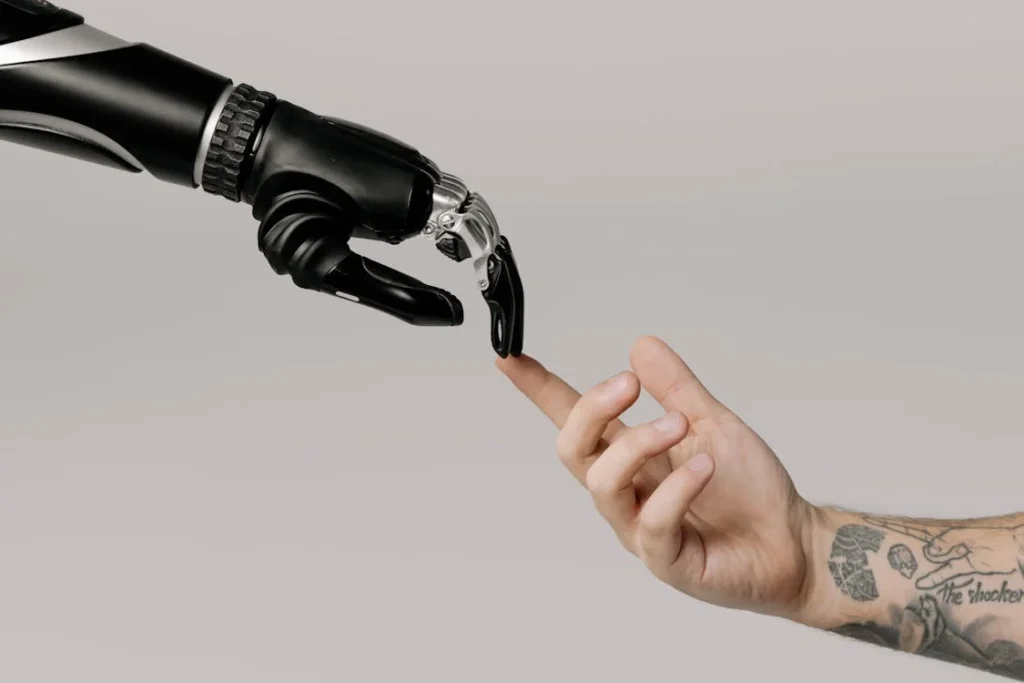
The Role of Rehabilitation in Maximizing Prosthetic Potential
Receiving an advanced prosthetic limb is only the first step in the journey toward independence.
The real challenge lies in adapting to its use and integrating it into everyday life. This is where rehabilitation plays a crucial role.
A structured rehabilitation program helps individuals develop the necessary strength, coordination, and confidence to fully utilize their prosthetic limb.
Learning to Use a Prosthetic: The Adjustment Period
For most new prosthetic users, the first few weeks can be challenging. Movements that once felt effortless now require conscious effort and practice.
Even with advanced myoelectric or bionic hands, the brain needs time to establish new motor pathways and learn how to control the prosthetic efficiently.
Occupational therapists play a key role in this phase. They guide users through exercises that improve grip strength, dexterity, and coordination.
Simple tasks like picking up a spoon, tying shoelaces, or holding a cup require repetition and muscle memory training.
Many users start with basic movements and gradually progress to more complex activities as they gain confidence.
For Suresh, who lost his hand in an accident, the early days of wearing a prosthetic were frustrating.
At first, even gripping a pen felt unnatural. But through consistent rehabilitation exercises and the support of his therapist, he learned how to perform daily tasks efficiently.
Today, he works in an office environment, using his prosthetic hand to type, write, and perform other professional duties with ease.
Strengthening the Residual Limb for Better Control
A strong residual limb is essential for prosthetic comfort and control. Weak muscles can lead to instability, making it harder to manage movements.
Strengthening exercises, such as resistance training and stretching, help improve endurance and make prosthetic use feel more natural.
Physiotherapists often recommend exercises that target the shoulder, upper arm, and forearm muscles to improve control over the prosthetic.
These exercises not only enhance function but also reduce strain on the body, preventing long-term discomfort.
Deepak, an aspiring athlete, struggled with using his prosthetic arm for sports. Initially, he found it difficult to maintain control while gripping sports equipment.
After months of targeted rehabilitation focusing on muscle strengthening and balance, he was able to return to adaptive sports, competing at a national level.
His journey is proof that the right training can make prosthetic limbs feel like an extension of the body.
The Psychological Aspect of Prosthetic Rehabilitation
Adapting to a prosthetic limb is not just about physical training—it also involves mental and emotional adjustment.
Many users experience frustration, self-doubt, or even anxiety about social acceptance. This is why psychological support is an important aspect of rehabilitation.
Peer support groups, therapy sessions, and counseling can help users develop a positive mindset toward their prosthetic.
Many individuals find motivation in connecting with others who have faced similar challenges.
Seeing success stories and learning from experienced users can provide encouragement and practical insights.
For Neha, a university student, the psychological aspect of prosthetic use was more difficult than the physical one.
She worried about how her classmates would perceive her new prosthetic hand. Through counseling and support from her family, she gradually built confidence.
Today, she wears her prosthetic with pride, focusing on her ambitions rather than worrying about external opinions.
Gamified Rehabilitation: Making Training Engaging
Traditional rehabilitation exercises can sometimes feel repetitive, which is why gamified rehabilitation is gaining popularity.
Virtual reality (VR) and interactive training programs turn prosthetic learning into an engaging experience.
These programs simulate real-life tasks, allowing users to practice movements in a fun and controlled environment.
At Robobionics, we believe that rehabilitation should be as accessible and enjoyable as possible.
Our home-based gamified rehabilitation programs encourage users to train in a familiar environment, helping them adapt more quickly to their prosthetic limb.
By combining structured exercises with interactive experiences, we make rehabilitation less of a chore and more of an exciting challenge.
With the right rehabilitation strategies, prosthetic users can maximize their potential, regain independence, and embrace their new reality with confidence.
The journey may be difficult, but with determination, support, and proper training, prosthetic limbs can become a seamless part of everyday life.
Conclusion
The impact of upper limb prosthetics goes far beyond restoring function—they help people reclaim their independence, confidence, and quality of life. From regaining control over daily tasks to excelling in careers, sports, and social interactions, prosthetic users are proving that limb loss does not define their future.
Real-life success stories highlight the power of resilience and innovation. Whether it is an artist rediscovering their craft, an athlete competing again, or a professional returning to work, prosthetic technology is transforming lives. Advanced designs, sensory feedback, and rehabilitation programs are making prosthetics more intuitive, allowing users to adapt more naturally.
At Robobionics, we are committed to creating prosthetic solutions that empower individuals, ensuring they have access to the best technology and support. The journey may start with limb loss, but it continues with determination, adaptability, and the right tools to move forward. With every step, every grip, and every achievement, prosthetic users are redefining possibilities—proving that life after limb loss is not about limitations, but about new beginnings.



